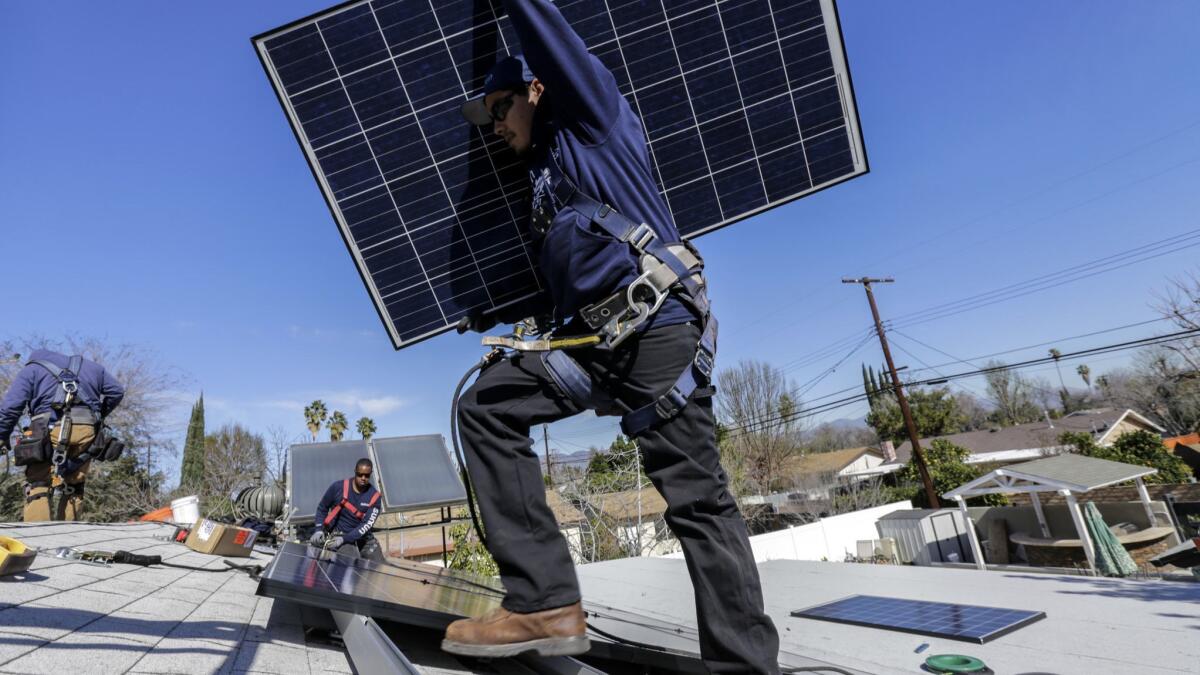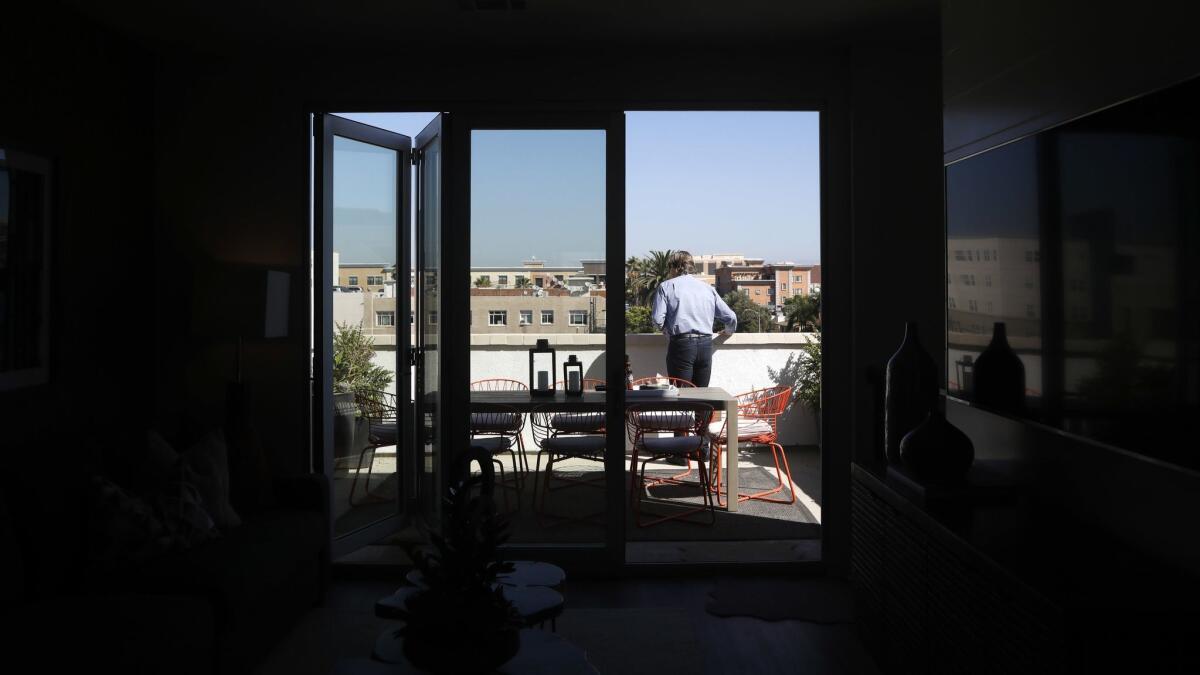Starting in 2020, all new homes in California must come with solar panels. Builders are getting ready

- Share via
When Irvine-based City Ventures started sticking solar panels on all of its homes six years ago, the builder emerged as a front-runner in the race toward energy-efficient home building. Soon it will be joined on the track by every developer in California.
Starting in 2020, California will become the first state in the nation to require all newly built homes to be solar-powered. And many developers are figuring out how to comply with the new rules while keeping their houses affordable.
The California Building Standards Commission approved the mandate this month, finalizing a unanimous vote from the California Energy Commission in May as part of the state’s ongoing battle against climate change. The rule applies to all single-family and multifamily residences of three stories or fewer.
“Too many home builders provide these features as an add-on, but that gives buyers a complicated choice,” City Ventures Chief Executive Phil Kerr said. “We felt it best to make solar power a standard part of the home, like bedrooms or countertops. Why wait until 2020?”
The Energy Commission estimates that solar panels will save homeowners an average of $19,000 over 30 years but add roughly $8,400 to the upfront cost of a single-family home — probably pricing many potential buyers out of the market.
According to a study from the National Assn. of Home Builders, every $1,000 increase to the cost of a home makes 52,903 households unable to afford a house. At that rate, a jump of $8,400 would keep about 444,385 households from buying a home.
Affordability is the main concern for the California Building Industry Assn., which represents around 3,100 builders across the state and 85% of all new single-family and multifamily housing production.
“For $2-million homes, these mandates might not be a big deal,” Chief Executive Dan Dunmoyer said. “But in markets like San Bernardino, this will be a factor for thousands of families trying to buy homes.”
The Energy Commission worked closely with developers over the last five or six years to give the industry some flexibility.
“Our hope is that this didn’t blindside anyone,” said commission spokeswoman Amber Beck, adding that the agency held meetings and took comments from stakeholders.
A decade ago, the state set a goal to reach net-zero energy use in residential homes by 2020, meaning homes produce enough energy to offset all their electric and natural gas needs. The solar panel mandate represents a step toward that goal.

Developers are the ones tasked with supplying the panels, so for buyers, the cost will be factored into their mortgage. From there, the choice is simple.
Home buyers can purchase the solar panels, which the Energy Commission estimates would result in net savings of $35 a month in energy bills with the mortgage increase factored in. Developers place the total energy savings at 50% to 70% based on the size of the system used, among other factors.
Homeowners also can lease the panels from a third party. In this scenario, the company would own the panel and its energy, and in return, give the homeowner a 20% discount on the electricity bill. Leases usually run for about 20 years.
Things are a bit more complicated for developers, especially those that build less-expensive homes; they will need to find the cheapest way to comply with the law to avoid losing their target customer.
For some, salvation may lie in the mandate’s allowance for “community-shared solar options,” which could translate to off-site solar farms that would send the energy to the homes via transmission lines. This option would require a bit more planning — as developers would have to buy land for the farms and find a way to distribute it — but could save both sides a small fortune.
Dunmoyer estimates that these farms could lower the cost per home from $8,400 to $1,200 thanks to economies of scale. They could be operated by the builder, a solar company or a local utility company and be located hundreds of miles away from the home, since electricity can travel at about the speed of light, California Building Industry Assn. scientist Andrew Kosydar said.
Sacramento Municipal Utility District, which provides electricity to Sacramento County, is currently seeking certification for its SolarShares program. Set to launch next year, it allows new home buyers to receive solar energy from a system built and maintained by the district.
“We’re hoping to expand this affordable option because these new requirements are creating demand,” Dunmoyer said.
Finding affordable options before the mandate goes into effect on Jan. 1, 2020, will be crucial for developers hoping to attract a wide range of buyers.
“Solar was always considered a luxury item in the past. Now it’s going to be a necessity,” said Dan Spiegel, president and co-founder of DMS Contractors, a developer based in Santa Monica. He said the added cost could be a problem for some.
City Ventures has been topping all its new homes with two-kilowatt solar panel systems since 2012. While others are scrambling for solutions, it’s enjoying a nice head start while building a bevy of all-solar town homes across L.A. County: in Long Beach, Bellflower, Gardena, Montebello and Pico Rivera.
Kerr said the homes he builds have no natural gas bills and electricity costs are 50% to 60% lower than with conventional construction. In September, City Ventures introduced Huxton, a community of 40 four-story town homes in downtown Long Beach.

For the city of Long Beach, which is currently pushing for climate change adaptation of its own by curbing greenhouse gas emissions, City Ventures’ priorities matched up quite well.
“It’s nice to work with a partner that gets it. They’re trying to address the same issues that we are,” said Christopher Koontz, Planning Bureau manager for Long Beach’s Development Services department. “It’s not just solar panels on the roof. They have electric stoves, EV charging stations, and a place to both store your bike and fix it.”
The early sales success of the town homes, at a time when plenty of non-solar options are still being built, perhaps highlights a public interest in energy-efficient houses. The development is in its third phase, and so far, 18 of the 40 have sold in Long Beach. The Bellflower development has sold 25 of 32 homes, and all 35 homes have sold in Montebello.
The nation’s largest home construction company, Lennar Corp., builds about 50,000 houses every year and has been preparing for this day as well. Five years ago, it created SunStreet Energy Group, which produces and maintains solar panel systems in homes for Lennar and a handful of other developers.
While many solar panel systems are retrofitted after the home is built, SunStreet builds them into the fabric of the house during the construction process.
“It’s done in pieces like an assembly line, which is completely opposite from the way most of the industry operates,” SunStreet Chairman David Kaiserman said.
He said the process is easier when done along the way because builders can avoid the hassle of drilling into roofs and running wires along the outside of the home.
For now, Lennar relies on rooftop panels as opposed to off-site solar farms, but Kaiserman noted that the quest for affordable solutions naturally leads to innovation.
“We haven’t seen much disruption in the industry because it’s largely been an options-based business. Now that solar panels are standard, there will be a heightened focus on innovation,” he said.
Lennar currently outfits the vast majority of its California homes with solar panel systems, Kaiserman said, but the mandate will force the builder to bump that up to 100%.
For some cities in California, the solar mandate will be nothing new. In the last three years, 16 local governments have approved energy standards for newly constructed homes in their communities, including the cities of Santa Monica, Del Mar and Fremont.
Twitter: @jflem94
More to Read
Sign up for Essential California
The most important California stories and recommendations in your inbox every morning.
You may occasionally receive promotional content from the Los Angeles Times.







